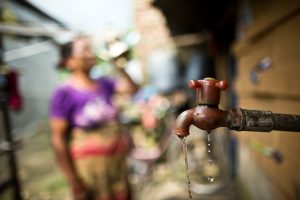
If we hope to regain progress on the Sustainable Development Goals—and improve people’s lives— we must improve water service delivery in ways that help countries better manage future crises and improve equitable access to water.
The pandemic has had a severe impact on the water industry in Asia and the Pacific but those involved in water supply, sanitation, and wastewater have been particularly hard hit, according to our research.
The disruption that the pandemic caused altered key drivers of the water sector—water demand and wastewater discharge—resulting in an abrupt decline in commercial and industrial water demand and wastewater generation. The decline, in turn, has triggered the need for rapid operational adjustments for the hard-hit service providers.
The revenue decline is the single biggest financial impact on water service providers. In our survey, two-thirds of water supply service providers saw a decrease in commercial and industrial revenues. Many utilities, particularly the smaller ones, have faced a steep decline in financial reserves mainly due to the sharp decrease in commercial and industrial water consumption which wasn’t fully offset by the increase in household consumption. Utilities that employ cross-subsidies on water tariffs are expected to be especially hit.
Many governments have intervened to ensure the continuity of critical water services during the pandemic, in some cases providing direct financial support to water service providers. In the absence of government relief, the financial burden of the pandemic is currently borne by water service providers.
In the recovery phase, the gradual opening of commercial activity and increasing mobility has eased the emergency protocols of service providers. However, the possibility of reversion back into emergency mode puts service providers on high alert. Even as commercial activity picks up, the recovery phase does not represent pre-pandemic economic activities and service providers are likely to operate at less than full capacity. Reduced capital and maintenance spending, as well as significant changes to operating and maintenance planning, may be achieved either through government transfers or increased customer tariffs.
To support the recovery of the water sector, the immediate priority for recovery should include ensuring public safety through the continuous provision of essential services while protecting the health of staff. Supporting the financial recovery of water service providers will require finding a balance between the need to extend continuing financial relief to customers and ensuring the resumption of critical capital works.
Lessons of the COVID-19 pandemic should also be integrated into planning and operations to increase resilience to future crises, and measures should be taken to protect the well-being and ensure social outcomes for vulnerable sectors.
It is expected that after the pandemic, there will be a “new normal” which may include flexible working arrangements, greater use of digital technologies, flexible pricing or payment schemes, and improved/ diversified/localized supply chains. In this new reality, we will see how the lessons and experiences from the pandemic have changed the way we live, work, and play.
Getting Asia and the Pacific back on track to achieve the Sustainable Development Goals (SDGs), particularly SDG-6, which calls for clean water and sanitation for all, will be a tall order. This is especially true in developing economies where government budgets are spread thinly across many priorities. The “SDG hat-trick” of sustained economic growth, eliminating poverty, and significantly reducing inequality is looking increasingly unlikely.
Getting Asia and the Pacific back on track to achieve the Sustainable Development Goals (SDGs), particularly SDG-6, which calls for clean water and sanitation for all, will be a tall order.
To prevent and mitigate future health crises more effectively, the water sector must consider the following solutions:
- Integrating water, sanitation, and hygiene (WASH) into the public health strategy by accelerating universal WASH access in line with SDG-6 will require large investments. We need to explore innovative methods for water and sanitation services such as decentralization and employing nature-based solutions.
- Improve crisis preparedness and response management of water service providers by using digital innovations that are increasingly available at cost-effective pricing and adopt technologies that add value to service providers and their customers.
- Create resilience in irrigation by improving productivity and market access, as well as adopting innovations in automation, mechanization, and e-commerce.
- Employ wastewater-based epidemiology.
- Green recovery strategies, including investments in water and sanitation, can deliver accelerated economic growth while protecting people and the planet.
Survey respondents also ranked the resumption of deferred capital works as the top priority that will support their post-pandemic and long-term recovery.
Private sector investment is another important component of financing water sector recovery and rejuvenation through public-private partnerships, however, countries with little or no prior experience with PPPs may take some time to embrace it. Financing support must be coupled with capacity building at the subsector level. Robust planning for crisis preparedness must include pandemic scenarios, through capacity building of service providers.
Water is critical to all aspects of life and livelihoods. As we emerge from the pandemic, water and sanitation must be prioritized if we hope to regain progress for the SDGs—and improve people’s lives.
The pandemic has given us an opportunity to improve service delivery in ways that help countries better manage future crises and improve equitable access to water.
About the Asian Development Blog
The Asian Development Blog is a forum for high-quality commentary and insights from ADB staff and other development experts about issues and challenges facing Asia and the Pacific.
The views expressed in these blogs are those of the authors and do not necessarily reflect the views of the Asian Development Bank, its management, its Board of Directors, or its members.